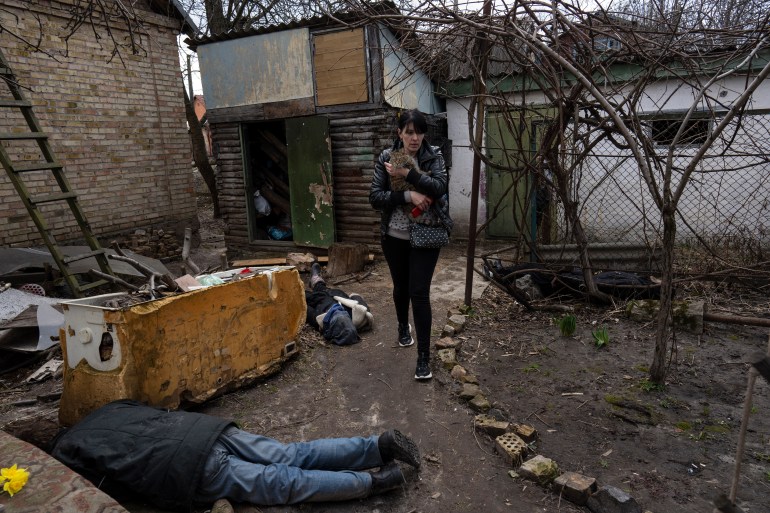Source: Researchers gather evidence of possible Russian war crimes in Ukraine | Russia | The Guardian
Six days after Russia launched its invasion of Ukraine, there is mounting evidence that its military is committing war crimes with deadly attacks on civilians and the use of cluster munitions.
Eliot Higgins, the founder of the investigative journalism site Bellingcat, said there was evidence of Russia causing “civilian harm”, including through the use of “cluster bombs in civilian areas”, from credible video and stills of the conflict.
Footage of an attack on a car park in Kharkiv on Monday, described by a Bellingcat researcher as a cluster bomb strike, shows residents walking in a nearby park just as the sequence of bombs go off. The area appears to be residential.
Dashcam footage, assessed by Russia’s Conflict Intelligence Team to have been shot in Kharkiv, is thought to show a cluster bomb landing in a road last Friday. The driver makes a hasty U-turn as explosions rain around the car. Given the lack of aircraft noise, the bomb was probably fired by a Russian Grad rocket system, the researchers conclude.
ICC prosecutor to investigate possible war crimes in Ukraine
Cluster munitions, which indiscriminately scatter small bombs over a wide area, are banned by more than 100 states including the UK, France and Germany because of their lack of precision. But neither Russia nor Ukraine (or the US) have signed up to a treaty first introduced in 2008 that bans them.
Further evidence of the use of cluster munitions has emerged, including the remains of a rocket motor from a BMP-30 Russian cluster munition found in road in Kharkiv on Friday, and video of a similar bomb part landing in Bucha, north-west of Kyiv.
Several NGOs have focused on an attack on a kindergarten in Okhtyrka, about 60 miles west of Kharkiv, on Friday, the second day of all-out fighting. Drone footage taken in the aftermath shows multiple blackened explosion spots, and dead or severely injured people by the entrance.
Three civilians were killed, including a child, said Amnesty International. “There is no possible justification for dropping cluster munitions in populated areas, let alone near a school,” said Agnès Callamard, the secretary general of Amnesty International.
Intentionally targeting civilians or civilian buildings is considered a war crime under international humanitarian law, as are attacks on military targets that cause excessive civilian casualties, according to the United Nations. Russia routinely denies it engages in illegal attacks.
Roos Boer, a project leader with the Pax peace project in the Netherlands, said: “If you are in doubt whether a target is military or not, you should presume it is civilian. An indiscriminate attack therefore is unlawful.”
Video evidence suggests Russian missile strikes on the eastern city of Kharkiv were launched with little regard for the impact on civilians. A missile strike on Tuesday – possibly a Kalibr cruise missile – on the regional government building in the centre of Kharkiv was filmed as it happened.
Missile hits central Kharkiv building as Russian attacks continue – video
At least 10 civilians were killed in the morning attack in the heart of the industrial city of more than 1 million people. Hours later, Russia said it would engage in what it called “high-precision” strikes on official buildings in Kyiv.
On Monday videos showed serial explosions from multiple launch rocket systems (MLRS) on other buildings in Kharkiv. One showed the distinctive 13-storey Diamond City tower clearly visible in the foreground. Bomb fragments were seen in roads in Kharkiv and rocket parts in apartments and dead civilians on the streets on a day where at least nine were killed.
But despite concerns raised by western intelligence, clear evidence is yet to emerge of Russian forces using destructive thermobaric weapons (although Ukraine has claimed capture of a TOS-1A flamethrower) or cluster incendiary bombs of the type that its forces were accused of using in Syria during the siege of Aleppo.
What are thermobaric weapons and how do they work?
On Monday night one western official said there was “a requirement to record and capture” attacks on civilians, while another said: “I think we will be very attentive and alert to war crimes or breaches of international humanitarian law in this conflict.”
But while governments talk about acting, researchers are already playing their part. Higgins said that unlike in other recent conflicts – such as the war in Syria – “an open-source intelligence community” collecting and studying video and photo evidence had emerged “from day one”.
Aided by the willingness of Ukrainians and others to document the conflict on their phones, independent researchers such as Bellingcat have been able to quickly geolocate and document evidence that could be useful in the future.
Bellingcat has also set up a partnership with Mnemonic, an NGO dedicated to archiving evidence collected from social media and mobile phones, which aims to secure material to the standard of evidence. “The day may come when all this ends up at the international criminal court,” Higgins said.



